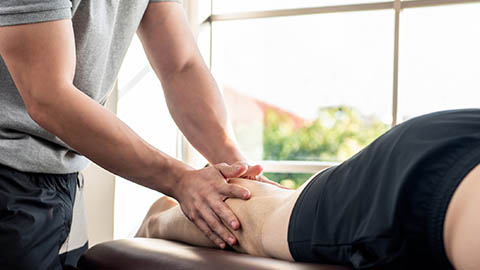02/19/2021

A client with a serious circulatory problem—a failed femoral-popliteal bypass, or “fem-pop” surgery—wants a massage while he’s waiting for his next procedure. There’s no data on massage and failed fem-pops at all. What can this massage therapist do? In this episode, we look at fem-pop surgeries and the reasons why a person might need it. Then, we take apart some of the variables that go into making decisions about massage therapy for this client. It’s a critical-thinking exercise with immediate repercussions for this client and his health and comfort.
Resources:
Jackson, M. R. et al. “The Consequences of a Failed Femoropopliteal Bypass Grafting: Comparison of Saphenous Vein and PTFE Grafts.” Journal of Vascular Surgery, 32, no. 3 (September 1, 2000), 498–505. https://doi.org/10.1067/mva.2000.108634.
Park, K.-M. et al. “Treatment of Failing Vein Grafts in Patients Who Underwent Lower Extremity Arterial Bypass.” Journal of the Korean Surgical Society, 83, no. 5 (October 29, 2012): 307–15. https://doi.org/10.4174/jkss.2012.83.5.307.
Stanford Health Care. “Femoral Popliteal Bypass.” Accessed February 18, 2021. https://stanfordhealthcare.org/medical-treatments/f/femoral-popliteal-bypass.html.
Walton, Tracy. “Massage Therapy Pressure Scale.” Accessed February 18, 2021. www.tracywalton.com/wp-content/uploads/2015/04/Walton-Massage-Therapy-Pressure-Scale-for-WEBSITE.pdf.


This podcast sponsored by:
Color Up makes 100% natural, cruelty free, and small batch hemp-derived CBD products intended to balance the mind, body, and spirit. “Color Up” describes our mission, our intention, and our values. It’s a symbol of health and wellness, a way to find balance and harmony, and a way to stay connected to Mother Earth and all her colorful offerings. All Color Up products aim to evoke the body’s natural ability to heal and balance. Our process begins with the proper care and study of the cannabis plant, and extends to our therapists, chemists, and cultivators who work alongside one another to create these intentional, healing products. Color Up formulations are crafted with deliberate, complementary ingredients, working with the body’s chemistry to bring relief, correction, and homeostasis!
Website: www.colorupco.com
Email: info@colorupco.com
Phone: 720-420-1734
Facebook: www.facebook.com/ColorUpTribe
Instagram: www.instagram.com/colorupcbd
0:00:00.0 Speaker 1: Ruth Werner's best-selling book, A Massage Therapist's Guide to Pathology is a highly regarded comprehensive resource that sets the standard for pathology education. Written for massage therapy students and practitioners, this groundbreaking resource serves up a comprehensive review of the pathophysiology, signs, symptoms, and treatment of more than 500 diseases and disorders. Learn more at booksofdiscovery.com.
0:00:32.2 S1: ABMP members receive 10% off 2021 pricing on the Color Up cannabis master program core classes and receive $150 in complementary products with the program. This online course is designed for professionals to learn about CBD, the endocannabinoid system, and why bringing CBD body care and even skin care into your practice is more than just a trend, it's a comprehensive approach to functional healing for body, mind, and spirit. Color Up makes it easy and affordable to introduce Color Up's professional spa products into your practice. ABMP members access your special promo codes by logging into your ABMP member discounts page at abmp.com/discounts or visit colorupco.com to learn more.
[music]
0:01:33.7 Ruth Werner: Hi, and welcome to I Have A Client Who, pathology conversations with Ruth Werner, the podcast where I will discuss your real life stories about clients with conditions that are perplexing or confusing. I am Ruth Werner, author of A Massage Therapist's Guide to Pathology, and I have spent decades studying, writing about, and teaching about where massage therapy intersects with diseases and conditions that might limit our client's health. We almost always have something good to offer, even with our most challenged clients, but we need to figure out a way to do that safely, effectively, and within our scope of practice. And sometimes as we have all learned, that is harder than it looks. Today's case comes from the other side of the world, and it goes like this.
0:02:24.8 RW: "Hi, Ruth, I am a registered massage therapist in Auckland, New Zealand, and I was wondering if you could help me with a client, please. I haven't seen him yet, but he underwent femoral popliteal bypass surgery in November. Unfortunately, the new vein has become blocked already, and now he has critical limb ischemia. I have requested the specialist report, as well as the report from his physio, he's hoping massage will give temporary relief to his leg until his further surgery later this year. I can't find any research with regards to the benefits of massage for this, and I don't wanna cause any further damage if I massage his leg. Any help or information would be greatly appreciated."
0:03:10.2 RW: Wow. Here's a complicated one. I dove into this rabbit hole a bit and I got to learn some new things, which is something I treasure about doing this podcast. If you'd like to send me down rabbit holes that are relevant to your work, be sure to send me your I Have A Client Who story, you can do that through my professional Facebook page, which is Ruth Werner's Pathology page, or through a dedicated email account at ihaveaclientwho@abmp.com. That's ihaveaclientwho, all one word, all lowercase @abmp.com. So let's talk about this procedure. A femoral popliteal bypass, which is sometimes called Fem-Pop. Isn't that a great name? This is a procedure in which a length of vein, usually a piece of saphenous vein is harvested and patched into a section of the femoral and/or popliteal arteries, because that section of the artery is no longer functioning. Sometimes a prosthetic graft might be used instead.
0:04:13.4 RW: Just like in surgeries with coronary arteries that might be more familiar to some of us, some patients are good candidates for an alternative option called percutaneous transluminal angioplasty. In this procedure, the surgeon inserts a catheter into the femoral artery and inflates a tiny balloon where the blockage is. They might also insert a stent, it's just like balloon angioplasty in the heart, but it's in the femoral or popliteal arteries. Fem-Pop surgeries are almost always a consequence of peripheral artery disease, a type of atherosclerosis, where plaque and debris and gunk clog up a portion of an artery, so all the tissues downstream of that area are deprived of oxygen and nutrition and they are at risk for dying. When this happens in the coronary arteries, we call it coronary artery disease, and of course, this is a big predictor for the risk of heart attack. When it happens in the carotid arteries, it's called carotid artery disease, and it's a predictor for the risk of ischemic stroke. But when it happens in the trunk or the extremities, This is peripheral artery disease or PAD and left untreated, PAD can cause a lot of pain and disability from a situation called intermittent claudication.
0:05:34.6 RW: And this is a problem where the leg muscles go into painful spasms because of lack of oxygen. Untreated peripheral artery disease can also lead to wounds that don't heal, a risk of infection or even gangrene and a danger of losing the limb because of decreased blood flow. In the realm of atherosclerosis, peripheral artery disease is not the most common manifestation, because the coronary and carotid arteries are usually affected first. I have a friend who had to have emergency surgery when a blockage in her abdominal artery caused the death of some tissues in her intestines, but that's pretty unusual, and I'm happy to say that she came through it very well. Peripheral artery disease is usually something we would expect to see with someone who has a pretty advanced atherosclerosis throughout the rest of their body and/or some other kind of underlying condition that might put them at risk for this. And as it happens, this client turns out also to have type 1 diabetes. We don't know anything more about him than that, but the fact that he has gone through this surgery and his implant is already clogged, makes me wonder how successfully his diabetes is managed.
0:06:53.4 RW: I looked up failed femoral popliteal bypass, and I found out that this situation is not that unusual, especially when a prosthetic graft is used, emergency re-vascularization surgery was required for 28% of patients in a large group, at least according to a 2000 study. And I'll share that study with you in the show notes. So, this person's femoral popliteal bypass failed, the grafted vein is all clogged up and he's due for a follow up surgery, and if this is delayed too long, he could be at risk for losing his leg. The client hopes that massage will give temporary relief to his leg while he waits for his corrective surgery. Huh. There's not a lot of information here. The massage therapist has asked to consult with his healthcare team before they proceed, which is of course a really great idea. And what we know is that because this clogged artery is the problem, if something should loosen, it's gonna go downstream into his leg rather than upstream toward his lung, which is what we would see with a problem in a vein rather than an artery.
0:08:06.6 RW: But if we put this through a pretty simple risks versus benefits filter, here's what I see, the risks are substantial. This person has damaged blood vessels in his leg with the possibility of infection and infarction, that's tissue damage from total blockage and maybe even the loss of his limb, he has type 1 diabetes, which means his blood vessel damage might not be limited to his affected leg. He's probably using anticoagulant medication among others, and when we look at all of those things, they all present risks for some types of massage, especially anything that specifically manipulates the tissues, but can we see any possible benefits? Well, if what he wants is pain relief, remember the temporary relief he asks for is not defined here. Then gentle soothing, non-disruptive touch could be just the thing. I talked this over with my friend Cal Cates, who is the executive director of Healwell, and that's an organization that specializes in massage for people affected by serious illness, and we agreed that only the lightest touch is probably appropriate for this client's leg.
0:09:20.8 RW: I suggest a Walton's scale level one or two, assuming it's safe for him to apply lotion and his skin is intact. I'll put a link to the Walton scale in the show notes too, but a short-hand version is this, level one is light lotioning and level two uses just a bit more pressure and traction, but it just affects the skin. This plus soothing, non-challenging massage to the rest of his body, so his leg can be incorporated, look at that word in-corpor-ated, the body or corpor is woven as one. If we can do this without making demands on an impaired cardiovascular system, that would be terrific, and it also minimizes the possibility of causing bruising related to anticoagulant use, assuming that that's part of his picture. The contributor is right that we don't have any evidence base to provide guidance about massage therapy for clients who have failed Fem-Pop surgery. So we have to rely on our own understanding of how our work intersects with our client's physical state to solve this puzzle. In this way, we can use the principles of critical thinking, we have to analyze the question at hand, look for reliable information, look for maybe some similar situations that might be helpful, check in our assumptions, take appropriate action and then monitor results so that we can continue to respond to what happens.
0:10:50.1 RW: And we can apply the principles of evidence-informed practice, that's making decisions based on client values, practitioner expertise, and what the research says. And this way, we will know that we are bringing our very best to the table. For instance, this contributor is curious to know about whether foot massage might be appropriate for this client? Let's think about that for a minute. Imagine this person on your table, imagine what his foot is like on the affected side of his body. For me, this is an it depends kind of question. What does it depend on for you, what would make you not want to work with the foot on his affected side and what would make you feel that it's probably fine? Without knowing more about this client, the key variable for me is the health of his tissues and his general resilience. If his foot is warm and if local circulation is responsive to massage, that is to say his skin turns pink with pressure, then a soothing foot massage, this is probably fine. But if his foot is cold and clammy, especially if it is edematous, well, that makes me question his circulatory health, and I would suggest only the gentlest kind of massage and warming holds.
0:12:10.4 RW: People with expertise in lymphatic work might have more to offer here, but that's not my bailiwick, so I am not qualified to make any recommendations about that. I'm hoping to hear back from this contributor about how things went when she finally gets to see this client. If there's anything to add to this conversation, I'll be sure to let you know. It doesn't happen often when we have to say that most massage is really out of bounds for this client's safety, and we can only use our gentlest and least invasive tools to help ease pain, lessen anxiety, lower stress, and improve quality of life. But this could be one of those situations where we have to hold on to those very, very careful parameters.
0:12:53.0 RW: Hey everybody, thanks listening to I Have A Client Who, pathology conversations with Ruth Werner. Remember, you can send me your I have a client who stories to ihaveaclientwho@abmp.com. That's ihaveaclientwho, all one word, all lowercase @abmp.com. I can't wait to see what you send me and I'll see you next time.
[music]
0:13:22.3 Speaker 3: Anatomy Trains is excited to invite you to a new two-day dissection live stream specialty class, the deep front line and central nervous system, February 27th and 28th. This advanced dissection live-stream educational experience is presented by Tom Myers and Todd Garcia, together in the lab for the first time in a year. In four two-hour sessions, we will explore detailed anatomy and the fascial connections in the ventral core. What Tom Myers termed the deep front line, moving onto the brain, spinal cord and fascial membranes that surround the central nervous system in the dorsal cavity. This special dissection live stream format allows us to explore more deeply subjects in areas of interest. Visit anatomytrains.com for details.





